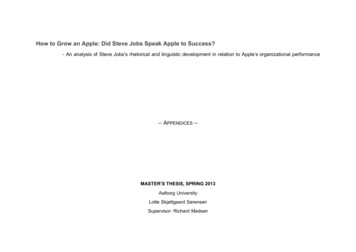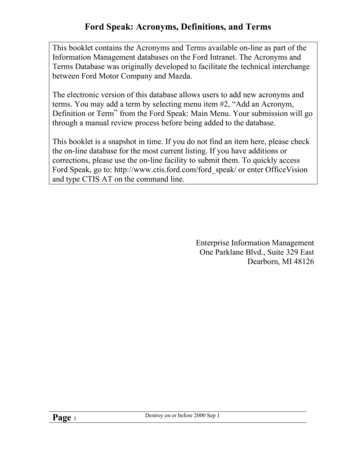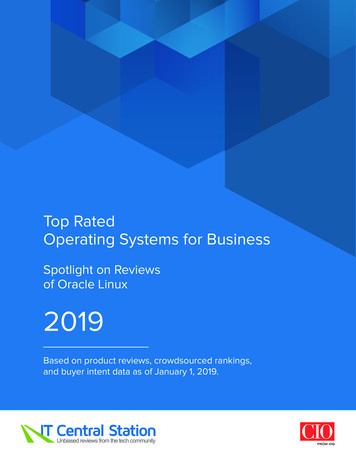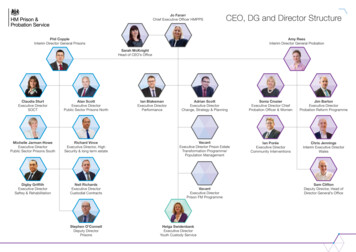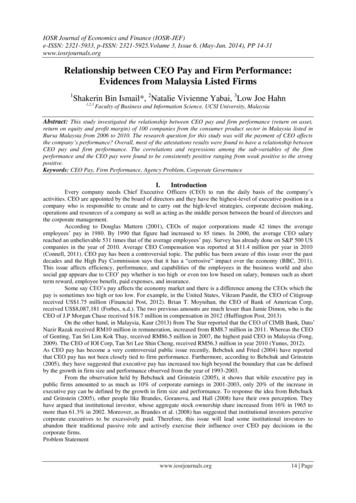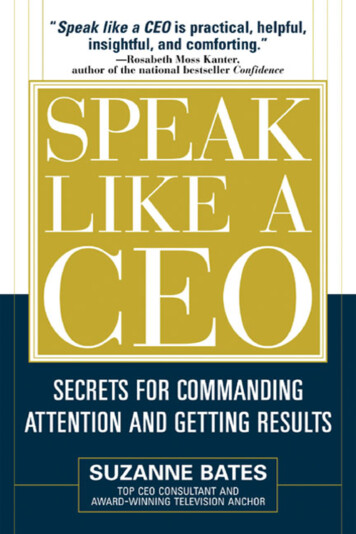
Transcription
Praise for Speak like a CEO“Speak like a CEO is practical, helpful, insightful, and comforting.Suzanne Bates helps leaders (even the most podium-shy) learn how to findtheir natural and authentic voice. And she does this with an informedunderstanding of the real everyday work of leaders.”—Rosabeth Moss Kanter, Author of the National Bestseller Confidence: HowWinning Streaks and Losing Streaks Begin and End“Suzanne Bates’s advice is concise and practical. Communication withinyour organization and with the media is critical to image and success. Thisbook will help every executive do a better job.”—Chris Hansen, Dateline NBC Correspondent“Suzanne Bates’s book provides a wealth of usable information in an easyto-use format that will prove useful and effective for leaders in all sectors:public, private, or not-for-profit. At the end of the day, whether you are theCEO of a company or a government leader, the efficacy of your leadershipis dependent on not only the quality of your ideas but your ability to effectively communicate them. Execution depends on energizing and engagingkey groups of influencers, and communication that engenders support andenthusiasm is a necessary skill.”—Jane Swift, Former Governor of Massachusetts“It is neither the smartest nor the hardest working CEO who succeeds inbusiness. It is the one who best communicates his or her firm’s vision tocustomers, vendors, and employees. Speak like a CEO shows you how.”—Tom Stemberg, CEO of Staples
“Speak like a CEO is a must read for any professional who recognizes thekey to success: building relationships. Whether you’re giving a speech,meeting with employees, or networking with potential customers, this bookwill teach you how to master the art of communication so you can conveyyour message with warmth, authenticity, and conviction. If you want a bigedge over the competition, you need to read this book!”—Cheryl Richardson, Author, Take Time for Your Life“Every CEO needs this step-by-step primer on how to speak authentically.Speak like a CEO shows leaders how to prepare for the unexpected.”—Vicki Donlan, Publisher, Women’s Business“Must reading for anybody who wants to make a connection—whether it’sthrough a TV screen, in a boardroom, or on a stage.”—Miles O’Brien, CNN News Anchor“One of the most concise, direct, impactful studies, not only on what ittakes to be your best at public speaking, but more importantly, what ittakes to lead. It is not a one-time read. In preparing for each new publicaddress, I try to emphasize one or another of Suzanne’s techniques forimproving communication. It really works. It can transform the anxiety ofpublic speaking into positive anticipation.”—Timothy J. Barberich, Chairman and CEO, Sepracor, Inc.“All managers will benefit from reading Suzanne Bates’s book Speak like aCEO. Today, with so many competing alternatives, leadership requiresbeing able to communicate well the company’s opportunity and vision. Aleader must be constantly recruiting employees, candidates, customers,suppliers, and investors to that vision. The better the leadership—thefaster the pace—the more immediate the success.”—Benjamin Nye, Partner, Bain Capital Ventures
“In Speak like a CEO, Suzanne Bates points out that the skill set needed torise within an organization does not usually include the single skill mostneeded as one rises closer to the top: the ability to communicate. In a bookthat manages to encourage personalization of style even as it prescribesthe steps that need to be taken to become a more effective speaker and presenter, Bates succeeds by showing rather than telling. In doing so, itbecomes clear that Speak like a CEO is for any of us who wish to stand upin front of an audience with greater confidence, preparedness, and abilityto connect. Clearly it is not just a book for CEOs.”—Russell T. Abbott, Principal, Treflie Capital Management“Suzanne has written a book based on solid research and nailed key concepts regarding communication and leadership in a clear, concise, andentertaining way.”—Anne Hawley Stevens, Founder and Managing Partner, ClearRock, Inc.“A practical how-to guide. Reading this book may not make you a CEO,but it should make you sound like one.”—Charles Stein, Business Columnist, Boston Globe“Executive presence, leadership, and style—three great attributes that caneasily be achieved by reading this book.”—Mary Lou Andre, Author, Ready to Wear: An Expert’sGuide to Choosing and Using Your Wardrobe“I was amazed at how accurately this book captures the challenges thatCEOs face everyday. Speak like a CEO is insightful, honest, and instructive. It is a must read for people who want to be taken seriously as a publicspeaker.”—Pamela J. Montpelier, President and CEO, Strata Bank
This page intentionally left blank.
SPEAKLIKE ACEOSECRETS FOR COMMANDINGATTENTION AND GETTING RESULTSwSUZANNE BATES
Copyright 2005 by Suzanne Bates. All rights reserved. Manufactured in the United States of America.Except as permitted under the United States Copyright Act of 1976, no part of this publication may bereproduced or distributed in any form or by any means, or stored in a database or retrieval system,without the prior written permission of the publisher.0-07-146617-7The material in this eBook also appears in the print version of this title: 0-07-145151-X.All trademarks are trademarks of their respective owners. Rather than put a trademark symbol afterevery occurrence of a trademarked name, we use names in an editorial fashion only, and to the benefitof the trademark owner, with no intention of infringement of the trademark. Where such designationsappear in this book, they have been printed with initial caps. McGraw-Hill eBooks are available atspecial quantity discounts to use as premiums and sales promotions, or for use in corporate trainingprograms. For more information, please contact George Hoare, Special Sales, atgeorge hoare@mcgraw-hill.com or (212) 904-4069.TERMS OF USEThis is a copyrighted work and The McGraw-Hill Companies, Inc. (“McGraw-Hill”) and its licensorsreserve all rights in and to the work. Use of this work is subject to these terms. Except as permittedunder the Copyright Act of 1976 and the right to store and retrieve one copy of the work, you may notdecompile, disassemble, reverse engineer, reproduce, modify, create derivative works based upon,transmit, distribute, disseminate, sell, publish or sublicense the work or any part of it without McGrawHill’s prior consent. You may use the work for your own noncommercial and personal use; any otheruse of the work is strictly prohibited. Your right to use the work may be terminated if you fail tocomply with these terms.THE WORK IS PROVIDED “AS IS.” McGRAW-HILL AND ITS LICENSORS MAKE NOGUARANTEES OR WARRANTIES AS TO THE ACCURACY, ADEQUACY ORCOMPLETENESS OF OR RESULTS TO BE OBTAINED FROM USING THE WORK,INCLUDING ANY INFORMATION THAT CAN BE ACCESSED THROUGH THE WORK VIAHYPERLINK OR OTHERWISE, AND EXPRESSLY DISCLAIM ANY WARRANTY, EXPRESSOR IMPLIED, INCLUDING BUT NOT LIMITED TO IMPLIED WARRANTIES OFMERCHANTABILITY OR FITNESS FOR A PARTICULAR PURPOSE. McGraw-Hill and itslicensors do not warrant or guarantee that the functions contained in the work will meet yourrequirements or that its operation will be uninterrupted or error free. Neither McGraw-Hill nor itslicensors shall be liable to you or anyone else for any inaccuracy, error or omission, regardless ofcause, in the work or for any damages resulting therefrom. McGraw-Hill has no responsibility for thecontent of any information accessed through the work. Under no circumstances shall McGraw-Hilland/or its licensors be liable for any indirect, incidental, special, punitive, consequential or similardamages that result from the use of or inability to use the work, even if any of them has been advised ofthe possibility of such damages. This limitation of liability shall apply to any claim or causewhatsoever whether such claim or cause arises in contract, tort or otherwise.DOI: 10.1036/0071466177
For more information about this title, click onxvPAR T 1The Secrets: What CEOs and Leaders Know1. What It Means to Speak like a CEO(the Ones You Really Admire)32. Eight Secrets of Successful CEOs andLeaders Who Speak Well173. You’re as Good as You Decide to Be274. What You Can Learn from Ten Thousand Leadersand Working on TV for Twenty Years375. The Eight Most Frequent Mistakes People Makein Front of Crowds and Cameras476. The Authenticity Gap: Why the Real YouMust Shine Through57vii
viii Contents7. Taking Stock: How Do Your Skills Add Up?678. Creating a Plan: Leaders Know It’s the Wayto Get Farther, Faster77PAR T 2The Situations: A Survival Guide for theEvents Where You Must Speak and Be Great9. Speeches9110. Presentations10711. Q&A Sessions: Thinking on Your Feet12112. Media Interviews13313. Leading Meetings14714. Conversations161PAR T 3The Strategies: Become a Great Speakerby Making a Plan and Working It15. Ten Things You Can Do to Guarantee Success17516. Five Coaching Plans183Appendix A Checklists191Appendix B Frequently Asked Questions195Appendix C Resources and Recommended Reading199Appendix D Communication and Leadership203Appendix E The Gettysburg Address: Abraham Lincoln211Index213
PrefaceBeing the top person in any organization is a great accomplishment,but it’s tough. Today, people expect more than ever of their leaders.Whether you are CEO, president, managing partner, executive director,owner, publisher, editor, king, or commander in chief, people expectmore. You work hard and make the most of luck to reach the top. Thenyou work harder to keep the job.If you aspire to the top job, you not only have to know your business—you have to know how to communicate with everyone else insideand outside the business. The higher you go, and the more visible youare, the more communication counts. You’re competing in a global worldwith instant communication. There is no forgiveness for the leader whocan’t keep up.My company is in the business of improving executive performancewith better communications. I call it “Tuning the Voice of Leadership.”This book shares techniques and skills that have helped many executivesand professionals do just that.Once you arrive in the top jobs, you’re expected to know what todo. Often we find our clients are surprised. Their early roles have not prepared them for the speaking roles. As you move up the ladder, you don’tnecessarily get opportunities to do what you need to when you’re the boss.You’ve been promoted for your business skill; now you have to develop awhole new set of competencies.ixCopyright 2005 by Suzanne Bates. Click here for terms of use.
x PrefaceWhy do you need to speak well if you’re a leader or if you aspire tobe? It’s simple: the smartest people aren’t necessarily the ones who rise tothe top. It’s the ones who can communicate well. If you don’t learn tospeak like a leader, you are in danger of being passed over for your dreamjob. This book will show you how to develop a personalized plan for mastering the skills you need.Whether you are the boss or you want to be, this book addresses someof the missing links. You will learn the principles for communicating likea leader—the things they don’t tell you in college or even on your way up.Why I Wrote This BookWhen I began coaching executives after twenty years in television news,I was struck by how little formal training leaders had in public speaking.Some had never attended any formal classes or worked with a coach.Some had been through a day or two of group training. Yet, they wereexpected to speak to large groups, deliver major keynotes, appear at important industry conferences, lead board meetings, talk to news reporters,and manage other high-pressure situations. I realized that there was aneed for a book that provides a sophisticated approach to speaking welland projecting authentic leadership.In this book, you will discover some of the secrets that I have discovered during my years in the media and then as an executive coach.The goal of this book is to share ideas that can help you develop a credible, authoritative leadership presence. The ideas and programs shouldshorten the learning curve and eliminate the pain of trial and error. Ifyou incorporate these ideas and work the programs, it will transform youfrom a so-so speaker or presenter to a good one.Who Should Read This Book?Even if you have experience making presentations; running meetings;talking to reporters; or participating in panels, conferences, and seminars,you will learn valuable lessons on how to make it in the big leagues ofbusiness here. Even professionals in the field—television and radio hosts,
Preface xinews anchors, and people who make a living at speaking—are lifelonglearners when it comes to communication skill. Top businesspeople mustinvest time every year in improving their communication skills if theywant to have an impact as thought leaders in their industries.What You Will LearnThe advice in this book goes beyond what you might find in a one-size-fitsall book on public speaking. This is not a standard book on presentationskills—it is a book that emphasizes the communication skills leaders musthave to succeed. When you finish this book, you will be able to create a personalized plan for self-development and be well on your way to becomingan authentic and credible speaker in front of crowds and cameras.Through exercises and self-assessments, you’ll learn to recognize anddevelop your own style. You’ll find nuts-and-bolts advice on how to improvespeeches, presentations, and media interviews in both content and style.Tips and techniques will help you develop your own authentic, natural styleand provide you with last-minute help to reduce the preperformance jitters.There’s also advice on how to speak in sound bites for TV, radio, or print.You’ll find out how to handle tough questions from a pack of reporters, waysto warm up an audience and keep people engaged—plus much more.Beyond the mechanics of speaking and appearing like a leader,you’ll learn how to win the trust of others so that they become willing tolisten to your ideas, understand your vision, and execute your strategies.The various chapters feature numerous examples of leaders who speakwell and explanations of how they do it so you can adapt it to your ownauthentic speaking style.How to Get the Most out of This Book:You Decide the Best Plan for YouThe book includes practical advice, inspiration, and a blueprint for developing your own authentic speaking style. There are several ways to usethe book—it’s up to you.
xii PrefaceYou can read the text all the way through to get an overview of howto speak like a CEO or an authentic leader. You can work on one aspect of communication skills over the coming months, especially if the subject is new to you. You may, for example,feel confident giving speeches but not as comfortable handling the press.Whatever you believe is a priority, turn directly to that chapter and begin. After you have read the book, you can refer to the end of each ofthe “situation” chapters in Part 2 for tips to help you prepare for speeches,presentations, meetings, and media interviews. Look for the “Summary”section, with entries listed by the categories “Last-minute tip,” “If youhave more time,” and “Plan for ongoing improvement.” Finally, you can use this book as a complete coaching guide: readit through, and work the strategies and recommended plans in Part 3 tocreate your own coaching plan. You may also want to hire a coach; Part3 includes advice on what to do and how to guarantee your success. Many people believe that speaking is a “nice-to-have” or “soft” skillthat should have little impact on their ability to rise to the top. But on thebalance sheet of business, not knowing how to speak is a liability. No onewho is serious about leading an organization would ignore a liability.Those who are serious would take note and start doing the things thatbuild the asset side of the balance sheet.In my experience, leaders really want and need information abouthow to speak well. While there are many books and courses on publicspeaking, most of them tend to focus on just the basics of presentationskills. There is absolutely nothing wrong with these books—read them!But if you believe you are beyond the basics, and you want to join theranks of great leaders who speak well, read on. What you want is not onlypossible, but it is likely, if you apply what you learn here.
AcknowledgmentsMany friends and colleagues have made this book possible. I amdeeply grateful for the advice, encouragement, and support of Jenna Furdon, Ken Lizotte, Karen Hansen, Donya Dickerson, Lara Murphy, MaryGlenn, Tara Frier, Margrette Mondillo, Annie Stevens, Chris Storr, MaryLou Andre, Marcia Abbott, Paula Lyons, Ann Conway, Jim Norman, JanetPatterson, Eleanor Uddo, Vickie Sullivan, Marcia Reynolds, Karen Friedman, Cheryl Richardson, Aleta Koman, Ginger Applegarth, GinnyRehberg, Kasey Kaufman, Frank Ciota, Lisa Zankman, Margery Myers,Bob Lobel, Vicki Donlan, Kathy Venne, Gayle Sierens, and Mom and Dad.CEOs and leaders have generously contributed their time and wisdom. I am indebted to Charlie Baker, President and CEO, Harvard Pilgrim Health Care; Judy George, founder and CEO, Domain HomeFurnishings; Tom Goemaat, President and CEO, Shawmut Design andConstruction; John Hamill, Chairman and CEO, Sovereign Bank ofNew England; Paul Levy, CEO, Beth Israel Deaconess Medical Center(Harvard); Larry Lucchino, CEO, Boston Red Sox; Phil Lussier, President, Institutional Division, Citistreet; Chris Moore, CEO, Live Planet;Lori Morrissette, VP Human Resources, Citistreet; Ann Murphy, VP,O’Neill Associates; Tom O’Neill, President and CEO, O’Neill Associates;Peter Rollins, Chief Executives Club, Boston College; Dan Wolf,founder, President, and CEO, Cape Air and Nantucket Airlines; andArnold Zetcher, President and CEO, Talbots.xiiiCopyright 2005 by Suzanne Bates. Click here for terms of use.
This page intentionally left blank.
IntroductionIf you’ve ever had a great boss, chances are that boss knew how tocommunicate well. Leaders who communicate well have a big advantageover those who come to the job with just experience and technical skill.Experience and technical skill are assumed in those who rise to the top.Leaders who communicate well succeed because they can also articulatevision, share wisdom, and motivate others to action.Leaders have different styles of communicating. There is no oneright way. There is no cookie-cutter approach to communicating as aleader. The most successful leaders blend an authentic, unique style withthe best techniques and become extremely effective.Leaders do not succeed when they copy, imitate, or adopt someoneelse’s style. Leaders succeed when they do it their way. People see themas genuine leaders when they are genuine. Authenticity inspires trust.Trust creates willingness. Willingness creates successful organizations.A unique, authentic style is critical to a leader’s success. You haveto communicate in your unique way. Yes, you have to know the rules ofthe road to drive the car, or you won’t get where you are going. But onceyou know the rules, you must drive your own car, your way. You mustdevelop your own, authentic voice of leadership. Speak like a CEO willhelp you learn the rules of the road—the secrets of communicatingwell—and find your unique voice. You will discover how to be you andbe a leader.xvCopyright 2005 by Suzanne Bates. Click here for terms of use.
xvi IntroductionSpeak like a CEO isn’t going to tell you who to be. You have to figure out who you are. You have to learn the rules of the road and find yourown authentic voice of leadership if you want to speak like a CEO.Finding your unique voice is tremendously powerful. It helps youtranscend your title, to reach a position of true leadership. Your authentic voice is why you were hired for your job and how you will get peopleto listen so you can succeed. You, and only you, have been brought to thisorganization at this time because of your way of doing things. You owe itto yourself and your organization to allow that authentic voice to beheard.It is a lot easier to be you than to pretend to be someone you are not.A lot of people put on power suits and look the part. There’s nothingwrong with a great suit, but an ordinary leader in a great suit is still anordinary leader—not a person who inspires trust. The real you mustemerge and lead in order for your enterprise to succeed.If you are a leader, or want to be, you owe it to yourself and yourorganization to communicate well, in your unique authentic style. Youcannot be mediocre. You cannot be ordinary or average. A mediocre oraverage communicator risks being marginalized or deemed irrelevant. Amarginalized or irrelevant leader is dangerous to an organization. Youhave to communicate well, your way, so people believe in you. Peoplemust believe in you to be willing to follow.This is a different kind of book on speaking—it is for CEOs andpeople who want to be leaders and speak with an authentic voice. Youwill learn far more than the basics of presentation style or media interviews or leading meetings; you will learn what you need to do to find thatunique leadership voice. Whether you are the CEO or want to be theCEO someday, you have an opportunity right now, today, to develop andgrow one of your greatest assets—the authentic voice of leadership.
PA R T 1The SecretsWhat CEOs and Leaders KnowCopyright 2005 by Suzanne Bates. Click here for terms of use.
This page intentionally left blank.
1What It Means to Speak like a CEO(the Ones You Really Admire)“Every time you have to speak,you are auditioning for leadership.”—James Humes, American Lawyer, Speaker, and AuthorThe CEO’s RoleThe chief executive officer is the highest authority in the day-to-daymanagement of a corporation. This person usually has the ultimate executive power within an organization or company. The CEO usuallyreports to, and is a member of, the company’s board of directors. TheCEO may also be the chairperson of the board in small companies,although the two roles are separated in larger organizations. Either way,it’s a big job.A CEO is responsible to every employee, every member of theboard, and every customer or client, as well as the community and sometimes the industry. How can any CEO succeed without communicatingwell? It’s impossible.The title of this chapter includes the parenthetical “the ones youreally admire” because not all CEOs speak well. Some speak poorly.Some hardly communicate. For those CEOs, there are consequences.3Copyright 2005 by Suzanne Bates. Click here for terms of use.
4 Speak like a CEOThose who speak poorly are marginalized. Those who rarely communicate alarm people when they do. Business is about nothing but communication. One top CEO describes why rarely communicating isineffective: “It’s like blood through an artery: if you have never communicated and then suddenly do—whatever you say will be overwhelmed bythe mere fact that you have just communicated.”Leading is all about communicating. The leader’s job is generallynot to do; it is to communicate what is to be done. People must see, hear,feel, and believe in the vision. They must see, hear, and believe in you.You are the message, and the message is you.Whenever people are asked about the most important skill of aleader, communication is always at the top of the list. Even when CEOswere asked (in a 2002 survey by Chief Executive magazine and Hill &Knowlton) to state the most significant thing they could do (other thanincrease financial performance) to improve the company’s reputation, thetop response was “communicating to customers.” Number two was “communicating to employees.”Look at the busy schedule of a CEO on an average day, and you’llsee just how important communication is. Mike Eskew, chairman andCEO of UPS, says the itinerary of a typical business trip looks much likethis: Speak informally to drivers in the morningMeet with various management people for focus groups andtown hall assembliesAttend recognition eventsSit down with the customers and discuss their issues andconcernsSit down with the pressMeet with stakeholders—whether it’s business partners orcommunity leadersThere is nothing on CEO Mike Eskew’s busy schedule from morning to night but talking and listening. That’s the job requirement. That’swhat CEOs do.
What It Means to Speak like a CEO (the Ones You Really Admire) 5Why You Must Speak Well: The SpotlightIs Always on YouThe CEO of a firm with four hundred employees and 430 million inrevenue confided to me, “It would be nice to be invisible once in a while.”Unfortunately, you cannot wish the spotlight away. When you’re theCEO, you are in it 24-7. Somebody is always watching.“It’s not just public speaking,” the CEO explained. “It is body language, every minute of every day. If I walk around moping, they don’tthink something is wrong with me; they think something is wrong withthe company.” He continued, “I have learned not to mope. It doesn’tmean you’re not real with people. You have to be real. But you have toremember it’s not just about you.”Nationwide Survey: Leadersand CommunicationBates Communications wanted to understand more about the authenticleader, so, in 2004, we conducted a study on how bosses communicate.The online survey of 293 professionals revealed that people were disappointed. Most participants said their bosses didn’t communicate well,even though they indicated that communication is one of the most important skills a boss can have.We asked participants to rate their bosses on ten dimensions of leadership and to discuss their communication styles. We also asked aboutauthenticity and leadership. We gave them an opportunity to answer bothmultiple-choice and open-ended questions.The results show how important communication is in the workplace. Only 29 percent of participants working in professional servicesfirms, corporations, and private companies said there were enough articulate voices of leadership in their organizations. Yet, more than 90 percent said communication is a critical dimension of leadership. There is
6 Speak like a CEOa disconnect between the kind of leadership that organizations have andwhat they need. The bottom line for bosses: it’s time to learn to communicate more effectively.How important is it for the leader of your organization tocommunicate effectively?91.5% Very important—it’s a critical dimension of leadership7.8%.7%Somewhat important—it contributes to our successNot very important—other skills are much more criticalWhile most people said they respect their leaders, they also said theywould like them to communicate better. More than one-third said theywould be surprised, or even shocked, if the head of their company wereto speak to the organization and inspire others to follow.How surprised would you be if the head of your companywere to speak to the organization, clearly articulating a newdirection and inspiring everyone to follow?65.5% Not surprised—this person is an authentic voice of leadership26.3% Somewhat surprised—we rarely see that ability to articulate orinspire8.2%Shocked—this leader just doesn’t know how to do thatThe assessment was even worse for managers and executives whoare in the pipeline to leadership.
What It Means to Speak like a CEO (the Ones You Really Admire) 7How would you characterize the voices of leadership in yourorganization?29.0% There are many articulate, inspiring leaders49.8% There are some, but we could use more21.2% There are few, if any, true voices of leadership hereTop leadership received better marks, but the findings showed aclear need for more and better voices of leadership throughout the ranksof most companies and organizations.Since most people know more about their own bosses than theCEO, we asked respondents to rate their immediate superiors on a variety of communication dimensions. These bosses fared worse in the ratings on communication skills (listening, speaking skills, leadingproductive meetings) than on dimensions having to do with personal rapport (humor, candidness) or being the public face of an organization(articulating goals, representing the company). This indicates that bosseshave the raw material, but learning communication techniques couldonly enhance their ability to lead.Bosses scored lowest on the skills that leaders arguably need most:only 40 percent of the people surveyed said their bosses could lead productive meetings, 41 percent said their bosses were skilled at sharing critical information, and just 43 percent said the boss knew how to motivateand inspire others. This is not a resounding vote of confidence. In manyother business areas, such as customer service, a 40 percent success ratewould put you out of business.The Cost of Poor CommunicationWhat happens to bosses who don’t learn to communicate well? Theiremployees do not trust what they say and seek information elsewhere.
8 Speak like a CEOOnly about half of the people surveyed said that they learn what’s goingon with the boss by listening to what he or she says. The rest “watch”body language, listen to tone of voice, or go so far as to ask somebody elsein the organization.How do you generally tell what’s going on with your boss?52.2% By listening to what he or she says32.8% By observing his or her face, body language, and tone of voice15.0% By talking with other people about what they thinkWhat makes an authentic leader? The survey asked two open-endedquestions. Bates Communications categorized the respondents’ answersinto ten key dimensions of leadership. The number one quality thatauthentic leaders conveyed was honesty/integrity. Since these were openended responses, we treated them as qualitative
easily be achieved by reading this book.” —Mary Lou Andre, Author, Ready to Wear: An Expert’s Guide to Choosing and Using Your Wardrobe “I was amazed at how accurately this book captures the cha


